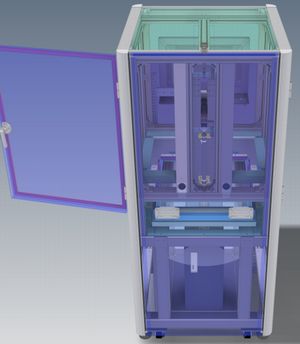OPEN HOUSE 2023 exhibited a flexibly transformable LED for the first time

Pic.2 Green transformable LED display |

Pic.1 White transformable LED display |
June 1-4th, OPEN HOUSE 2023 was held in NHK Science & Technology Research
Laboratories. As concerns display, two devices were proposed for realization
of immersive contents due to increase a sense of immersion.
In this time, NHK disclosed flexibly transformable LED displays for the first time. In this device, micro LED chips were mounted on a transparent acrylic rubber sheet. For this reason, it can be transformable by rubber sheet and stretchable electrode. In short, developed flexible display has been advanced moreover.
As concerns manufacturing process, first of all, a stretchable ink is printed on the original glass substrate by the ink-jet printing method, and dried. The next, micro LED chips are mounted on stretchable wiring. Finally, this original substrate is transferred to a rubber sheet by use of adhesive, and then, released from the original substrate. Stretch ratio is 40 %.
 Fig.1 Image of flexibly transformable display Fig.1 Image of flexibly transformable display
|
In this time, NHK has pilot-produced white LED display (16 Å~ 16 dots) and green LED display (32 Å~ 32 dots). The latter has fine resolution. For this reason, it's relatively easy to develop RGB full-color display in the near future. Furthermore, as figure 1, 3D structure display and wearable display are expected to be realized, too.
High color purity is obtained by Cd-free quantum dot
Another new exhibition was a quantum dot LED (QE-LED). NHK has disclosed
monocolor QE-LEDs in the past, but, exhibited a RGB full-color QE-LED in
the first time. In this pilot-produced panel, Cd-free material, concretely,
AgCuInGaS2, AgInGaS2, and ZnSe compound were used as R, G, B color respectively. As figure
2, high color purity was obtained such as BT.2020 cover 80%.

Fig.2 Color reproducibility of this QE-LED |

Pic.3 Full-color QE-LED |
Pilot-produce panel has 64 Å~ 64 pixel (0.6 áo pitch). QE emissive layer was directly patterned by the IJ printing method. On the other hand, other layers were formed by existence OLED technology (evaporation, coating, etc.). And also, 2 glass substrates were used as both substrate. However, NHK will develop flexible display using plastic substrate and thin film encapsulation in the future.
|




 Fig.1 Image of flexibly transformable display
Fig.1 Image of flexibly transformable display

